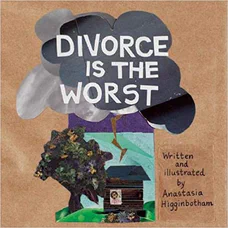Divorce Is the Worst

Recommended Age Range: 1st grade through 4th grade.
Publisher's Summary:
Part of the Ordinary Terrible Things series, Divorce Is the Worst is a funny but frank picture book for kids whose parents are going through a divorce. In her iconic straightforward-but-sensitive way, author Anastasia Higginbotham sheds light on how hard it is for children to stay whole when their whole world, and the people in it, split apart.

Dr. Annie's Takeaways
Recommended for: This book is excellent for a child who is hurt and angry about their parents’ divorce and who feels invalidated by books that imply that there might be good things about it (e.g., all of the books that include a line like, now you’ll have twice as many toys!). This book validates a child’s pain, reminds them that it isn’t their fault, and encourages them to express their feelings. It is a great book for a therapist or counselor to use prior to introducing a relevant therapy activity (e.g., writing out a child’s worries on strips of paper; making a collage of their feelings) and as a way to communicate that in therapy a child doesn’t have to act like everything is okay. Parents may find this book painful, as it is a reminder of how difficult divorce can be for children, but for many kids, it could be a relief to see that their parent recognizes and accepts their feelings about the divorce. The parents in this book are never pictured, so it works for divorcing parents of all genders.
Evidence-Based Practices:
Emotional Processing
Tone: Validating, authentic, a bit dark and gritty
Story Quality: Written in second person, this story jumps right in to validate that divorce is often really, really difficult for kids. In very few words, it expresses quite beautifully the pain of one’s parents separating, and it creates space for a child to share their feelings and experiences. The book ends with several activities to help a child to cope with their parents’ divorce.
Illustrations: The illustrations are really cool collages that look to be made of paper bags, string, fabric, and bits of magazines. They’re emotionally evocative and will likely inspire children to want to make their own collage art.
Representation: The book is written in second person, and no pronouns are used. The parents getting divorced are never pictured, and the parents’ genders are not implied. The child who is pictured in the illustrations has light brown skin (they are literally cut from a paper bag) and short brown hair; they could be a girl, boy, or nonbinary. There is a brief reference to some degree of shared custody (the child packs a backpack to go stay at their other parent’s home).
Psychological Practices: With evocative pictures and simple language, this book validates the pain of seeing one’s parents fight and cry, and it names some common side effects of parents’ challenges coping with a divorce, like accidentally not paying enough attention to what’s happening to their children. It normalizes having a lot of difficult feelings at once, and it normalizes different reactions a child might have (e.g., crying about small things, or not crying about big things). It gently encourages a child to name and feel their feelings rather than avoid them, and it empathizes with a child feeling pulled between their parents. At the end of the book, the author shares several activities to help a child to express their feelings and cope with a divorce, including writing out different feelings and worries that a child is carrying around in their “backpack,” picturing one’s feelings and worries as balloons that a child can share with someone they trust, and making a collage of a space where a child feels “all in one piece” that includes grounding-type strategies (e.g., “Choose the ground, rocks, roots, and grass that best support you”).
Concerns: None.
